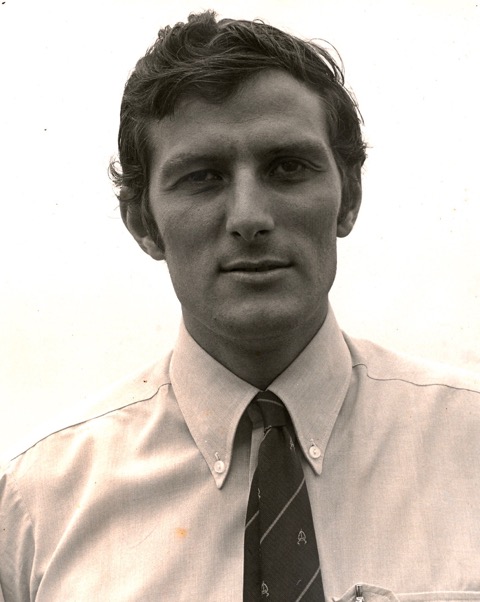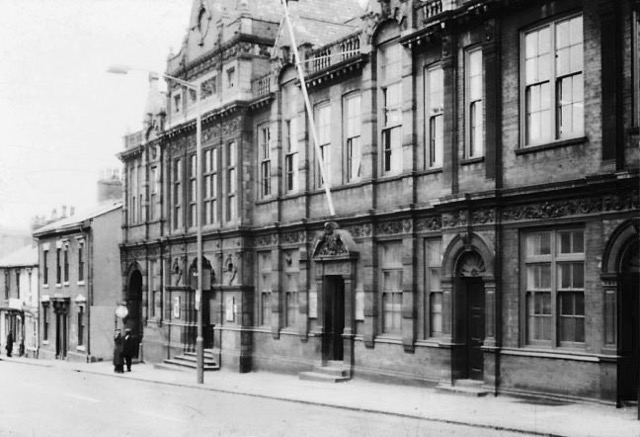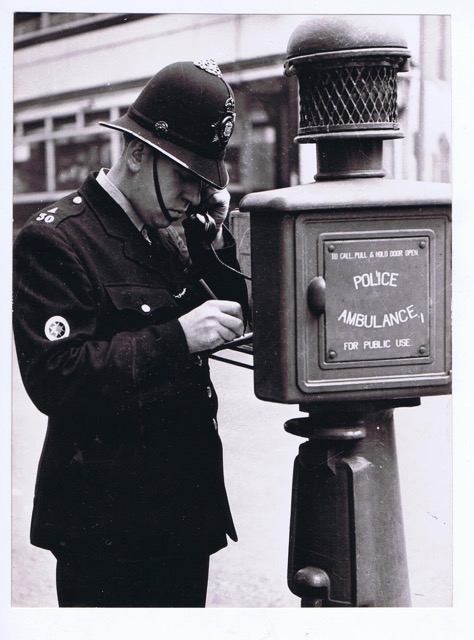Last ever sentence of Corporal Punishment

During the early evening of Wednesday 10th January 1968 Herbert George Karam, aged 56 stood in his brother’s bar – Casey’s Lounge on Queen Street – and took a large roll of banknotes from a box and put them in his pocket. Standing nearby two of his friends, Grenville ‘Peter’ Saltus and Ronald Young saw the indiscretion and Young remarked to Saltus that someday Karam would be robbed. Saltus replied that he had been thinking of robbing him himself, and suggested that he and Young should do it together. They agreed to do just that and the two friends left the bar and broke into Karam’s apartment on King Street through a side window. A conspiracy was underway.
Helping themselves to some neckties and beer, they lay in wait for two and a half hours planning what they would do when Karam came home. Saltus suggested that Young should throw a blanket over the victim’s head while Saltus would hit him with a piece of pipe. Meantime, they removed all the light bulbs in the apartment and continued the wait. Karam arrived home shortly after 10 p.m. and tried unsuccessfully to switch on the lights. He then went into his darkened bedroom where the two men were hiding, and they carried out their plan.
A blanket was thrown over Karam’s head and he was knocked to the floor. During a struggle on the floor both men beat him into submission with their fists. He became exhausted and lay still whilst Young went through his pockets.
The robbers left him on the floor bleeding from a head wound and fled with over US$2,500 and ₤295 in cash together with a wallet containing personal items. Karam was able to crawl to an adjoining apartment and summon help. He was rushed to the hospital.
At about 10.25 p.m. I was working the night CID duty shift with Pc Malcolm Hinds who was on loan to CID as a partner from Central uniform watch. We attended the scene of the robbery at ‘Galdwyn Apts’, King Street, Hamilton where we saw significant signs of a fight in Karam’s apartment. I closed off the apartment and instructed a police guard that no-one was to enter. I informed Police Operations of my findings and requested forensic assistance immediately.
At 10.55 p.m. we went to K.E.M.H. where we saw that Karam had been badly beaten about his head, face and stomach. He was in a state of shock and unresponsive to questions. There was apprehension that Karam might not survive the beating. Any questioning of Karam was impossible due to his state of shock. I detailed Pc Hinds to remain at the hospital and I returned to ‘Gladwyn’ to meet with scenes of crime officer Dc Calvin Christopher. I alerted Pc Hinds and the nursing staff to contact me immediately should there be any further deterioration in Karam’s condition. I considered the possibility of the need for a dying declaration.
On entering the secured apartment with Dc Christopher I saw that:-
- There was no immediate sign of a forced entry.
- Three light bulbs appeared to have been removed from a chandelier and placed upon a dice table nearby.
- Two empty Heineken beer bottles; one empty Tuborg beer bottle and one full and unopened Heineken beer bottle with a clean white handkerchief wrapped around it, - all lying on a dresser top.
- Two white handkerchiefs’ with twisted ends, consistent with having been used as face coverings – lying on a sofa near the scene of the struggle.
- An overturned wooden bench lying on top of a pair of gent’s spectacles
- A man’s broken wristwatch and a tie-pin lying on the floor together with patches of what appeared to be dried blood.
- A grey coloured army blanket on the floor in the area of the supposed struggle.
Dc Christopher continued working the crime scene throughout the night.
At 12.10 a.m. D/Superintendent Frank Hammond attended the scene and with him I went to Apartment No.6 but we received no reply to our knocks.
Initially working alone, I commenced what turned out to be convoluted enquiries at the adjoining apartments inside one of which, No.6, whilst questioning the inhabitant, I saw in full view certain articles of obviously stolen property. Pc Hinds joined me from the hospital and an arrest was made and certain stolen property recovered – not connected with the case under investigation
Resulting from information received and believing that someone else was hidden in apartment No.6, I requested further personnel assistance. Pc Hinds and I were joined around 4.00 a.m. by Pc Ralph Sealy. I sent Pc Sealy to the rear of No.6 and heard him shouting to someone. I continued knocking on the front door and announced ‘Police, open up’. There was still no reply.
From inside the apartment I could hear the sound of someone moving about together with sounds consistent with furniture being moved around. I saw a dim light shining through a curtain. Someone or something was moving around inside the apartment. I continued knocking and after six minutes from the first knock a man who identified himself as Grenville Chesterfield Saltus opened the door and invited us in. I saw he was shaking and trembling. I asked why and he replied, “Just cops that’s all.”
I asked why he had not opened the door to us earlier than he did, he replied, “Why should I open the door to the likes of you.” He slumped down in a chair as if exhausted. He muttered that we should not disturb him and that we had nothing on him anyhow. I explained the nature of our enquiries and asked where he had been throughout the evening. He replied, “Drinking alone round and about.” Pc Hinds spoke to him and received the replies, “I came in alone” and “You are entitled to your opinion.”
I said to Saltus, “I am arresting you on suspicion of having committed a felony. You are not obliged to say anything unless you wish to do so but what you say may be put into writing and given in evidence.”
Saltus said, “Search all you like Al Capone. If you find anything I’ve just got back.”
In company with Pc Hinds and Pc Sealy I made a cursory search of No.6 and took possession of certain articles of clothing and a tie rack from the wardrobe. I saw what appeared to be blood stains on the front of a dark blue leather jacket being worn by Saltus.
Continuing the enquiries later that same morning a detailed search was conducted of No.6 by CID officers led by D/Sgt Brinley Jones. Recovered from behind a wardrobe and a clothes dresser was cash and property belonging to Karem
Saltus was later charged and remanded in custody pending the arrest of his accomplice Ronald Young some days later. Both were charged with being concerned together in the armed robbery and both pleaded guilty in arraignments at the Easter Term of the Criminal Assizes.
Before sentencing the pair the Chief Justice, the Hon. Sir Myles Abbott, told them:
“You two men evidently worked out a successful plan, first to break into Mr. Karam’s house, then to lie in wait for him, and make a vicious attack on him; and a cowardly attack by two men on a man twice your age. You are fortunate that he did not suffer further injuries than possibly you even expected. He is not permanently injured but he might well have been. He might have been completely suffocated by the blanket and the blows you gave him with the pipe. This might have resulted in your being here on a very much more serious charge.”
He added that “it was a disgraceful piece of behaviour, particularly on the part of Saltus who I think was the ringleader in this conspiracy.”
In his sentencing the Chief Justice told Saltus that in addition to prison time he would get six strokes of the cane – “to teach you not to use personal violence.”
At a later Court of Appeal hearing the Appeal judges refused to reduce the sentences but they did set aside the additional punishment of six strokes of the cane in the case of Saltus. Chairman of the court, Sir Ronald Sinclair, said that the judges felt that corporal punishment should not be imposed in addition to long gaol terms. The punishment was never carried out.
Chairman of the court, Sir Ronald Sinclair, said that the judges felt that corporal punishment should not be imposed in addition to long gaol terms. “The sentences however are thoroughly deserved,” said Sir Ronald.
[The sentencing of Saltus to six strokes of the cane is believed to have been the last time such a sentence was handed down within the Bermuda jurisdiction.]
COMMISSIONER’S COMMENDATION:
Awarded to P.C. 112 G.F. Rose –
For intelligent appreciation and diligent enquiries in a brutal case of robbery with violence after a housebreaking by Grenville Chesterfield Saltus and Ronald McDonald Young
Saltus was sentenced to eighteen months and five years’ imprisonment concurrent, and six strokes of the cane. Young was sentenced to twelve months and three years’ concurrent.
Dated: 16th April 1968


